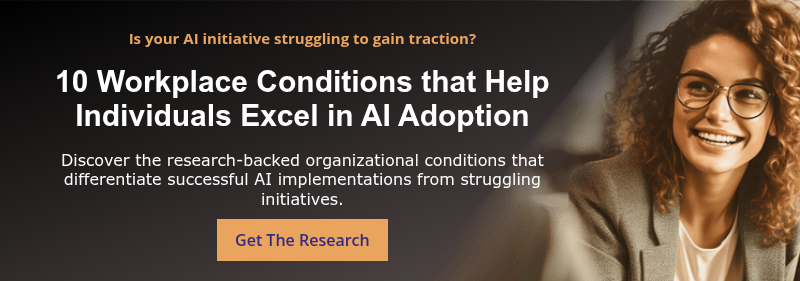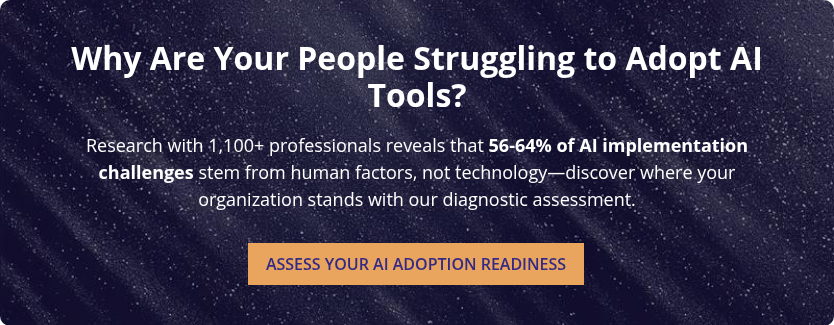AI Transformation: A People-Centric Guide to Leading Change

7 Mins
Updated: August 6, 2025
Published: May 8, 2025

AI is here, reshaping how organizations operate, compete and deliver value.
Yet while the technology accelerates, people’s readiness often falls behind. In a recent Prosci poll, 60% of respondents expected major disruption from generative AI. At the same time, more than 40% of companies are actively researching or piloting AI initiatives, and enterprise-scale deployments have nearly doubled since 2023.
That gap matters. AI transformation success depends on how well people adapt, adopt and apply new ways of working.
This guide outlines how to lead AI transformation with a people-first approach using the Prosci Methodology. It also explores how AI can support change efforts—enabling faster, more effective transformation at scale.
What Is AI Transformation?
AI transformation means using AI to improve how organizations operate, make decisions and innovate. But it’s more than adopting tools. It’s a shift in how people work and solve problems.
To unlock AI’s value, organizations must reshape culture, processes and mindsets—with people at the center.
Key components of AI transformation
AI transformation is a strategic shift that touches every part of the organization. Leading it effectively relies on several interconnected elements:
- Technology integration – Use AI tools like machine learning, natural language processing and automation to improve productivity and cut costs.
- Cultural shift – Build a mindset of curiosity, flexibility and learning. AI should enhance—not replace—human skills.
- Process redesign – Embed AI where it adds value. Automate what’s repetitive. Focus people on higher-impact work.
- Data quality – Strengthen data management to ensure AI can deliver accurate, reliable insights.
- Change management – Use a structured approach—like the Prosci Methodology—to guide adoption, build trust and drive success.
- Governance and ethics – Establish clear rules for responsible AI use, covering privacy, bias and fairness.

5 Types of AI Technology and Their Impact
Organizations are adopting five core types of AI to rethink how work gets done:
-
Machine learning (ML) – Powers predictive tools like fraud detection and demand forecasting.
-
Natural language processing (NLP) – Enables chatbots and virtual assistants to understand and respond to human language.
-
Computer vision – Automates visual tasks in sectors like manufacturing, healthcare and security.
-
AI-powered RPA – Combines automation with intelligence to manage complex, unstructured tasks.
-
Predictive and prescriptive analytics – Helps leaders make faster, smarter decisions.
These tools are helping teams move faster, solve problems earlier, and spend more time on what matters.
Benefits of AI Transformation
A Prosci study on generative AI adoption showed the top perceived benefits to be:
- Improved organizational success
- Increased personal success
- Greater project success
As AI adoption grows, the most tangible benefits include:
- Faster time to impact – AI speeds up workflows and shortens project cycles by automating repetitive tasks.
- Proactive problem-solving – Predictive tools help teams identify risks and opportunities earlier.
- Smarter resource use – AI frees up time and talent, allowing people to focus on higher-value work.
- Greater agility: Real-time insights and automation help organizations respond faster to change.
Top Perceived Benefits of GenAI Adoption
 But technology alone doesn’t deliver results. People do. If your team doesn’t adopt the change, the transformation won’t stick and these benefits won’t be realized.
But technology alone doesn’t deliver results. People do. If your team doesn’t adopt the change, the transformation won’t stick and these benefits won’t be realized.
The Importance of a People-Centric Approach to AI Business Transformation
Although 41% of companies are actively researching or piloting AI initiatives, Prosci research on AI implementation shows that human factors remain the biggest barrier to successful adoption. More than half of organizations cite challenges like resistance to change, lack of clarity, and skill gaps as key obstacles.
When you prioritize people in your transformation strategy, you set the stage to harness AI’s full potential.
“It is important to think about Generative AI as an extremely skilled intern, rather than an oracle. You go to an oracle to get answers; you go to an intern with tasks and iterate and collaborate toward valuable outputs. Unlocking GenAI will be central for organizations to elevate change success”.
Tim Creasey, Prosci Chief Innovation Officer
How a people-centered approach drives change
AI transformation is a people challenge as much as a tech one. If your team feels confused or left out, progress will stall—no matter how advanced the tools.
Here’s how a human-centric strategy will help you drive meaningful AI transformation:
- Address fears directly – Our study, Keys to Unlocking AI Adoption, found that 29% of employees worry about job displacement or role ambiguity. Transparent communication and visible leadership help build trust.
- Build engagement early – Involving people in the process strengthens alignment and fosters commitment.
- Close skill gaps – Our study on AI adoption revealed that 38% of challenges are tied to a lack of training. Equip your teams with the knowledge and confidence to use AI tools effectively.
- Promote collaboration – When people see AI as a partner, not a replacement, it encourages innovation across teams.
- Embed ethical AI use – According to Prosci’s research on AI adoption, 22% of respondents are concerned about ethical AI use. Clear standards and human oversight are key.
What Drives and Restrains AI Awareness?

Leading AI and digital transformation with people at the center
Understanding the need for a human-focused approach is just the beginning. Turning that insight into action takes structure and commitment. Here are practical ways to keep people at the heart of your AI transformation:
-
Communicate clearly and consistently – Explain the purpose and expected impact of AI. Use multiple channels and welcome feedback. Transparency builds trust.
-
Support learning and growth – Offer hands-on training, accessible tools and space to explore. Confidence builds through practice.
-
Involve people early – Seek employee input before launching initiatives. You’ll surface better ideas and identify roadblocks ahead of time.
-
Apply proven frameworks – Practical models like the Prosci ADKAR® Model provide a roadmap to guide people through change. Focusing on acquiring the ADKAR elements —Awareness, Desire, Knowledge, Ability and Reinforcement—equips and supports people at every level.
The Prosci ADKAR Model

- Listen and adapt – Use surveys, feedback loops and tracking tools to assess impact. Then act on what you learn.
Integrating Change Management Into the Stages of AI Transformation
AI transformation unfolds in phases—from early assessments to full-scale rollout and beyond. At each stage, applying structured change management helps you prepare and engage your people.
Here’s how to integrate change management, using our ADKAR Model, across the key stages of AI transformation:
The 6 Stages of AI Transformation

1. Preparation and assessment
This stage lays the foundation for your AI transformation. You need to understand the current state of your organization to then identify where AI can create the most value.
Integrating change management through the Prosci ADKAR Model:
Awareness – Clearly articulate the need for AI and how it aligns with organizational goals. At this stage, it’s crucial to engage leadership to communicate the importance of the change.
Desire – Show people how AI will benefit them personally, such as skills development or replacing mundane tasks. Address concerns by sharing how the change will be managed and what support will be available.
2. Strategy development
Once the organization understands the opportunity, the next step is building a clear roadmap. This includes defining objectives, scope, business processes and resources required.
Integrating change management through the Prosci ADKAR Model:
Knowledge – Educate teams and business leaders about the AI strategy, ensuring they understand the vision and how it aligns with their specific roles and business functions.
Ability – Identify skill gaps and design comprehensive training plans that will prepare teams for new ways of working. This includes helping teams transition away from routine tasks so they can focus on higher-value work.
3. Pilot projects
Pilot programs are a low-risk way to explore how AI works in your specific environment and gather real-world feedback before scaling.
Integrating change management through the Prosci ADKAR Model:
Ability – Facilitate hands-on training during pilot projects to build confidence in using AI tools. Let employees experiment and grow their comfort level with AI tools.
The Prosci study, Keys to Unlocking AI Adoption, shows organizations that actively encourage AI experimentation experience higher adoption success rates.
Reinforcement – Recognize early wins and collect feedback from participants to identify successes and areas for improvement.
4. Full-scale implementation
With pilot insights in hand, it’s time to scale. This stage involves deploying AI solutions organization-wide and driving consistent use across all relevant business functions.
Integrating change management through the Prosci ADKAR Model:
Knowledge – Provide clear documentation, role-specific training programs and coaching support to ensure all employees understand how to use the new AI systems effectively.
Reinforcement – Celebrate achievements, recognize early adopters and establish support systems to assist employees during the transition.
5. Monitoring and optimization
The journey doesn’t end at implementation. Ongoing success depends on how well AI systems adapt to evolving needs, performance data and changing business processes.
Integrating change management through the Prosci ADKAR Model:
Reinforcement – Conduct regular ADKAR Assessments to identify adoption challenges and address any barriers to success.
Desire – Foster a culture of continuous improvement by encouraging employees to share feedback, suggest improvements and take ownership of refining the tools they use.
6. Sustaining change
The final stage is about long-term integration. AI should become a natural part of how work gets done.
Integrating change management through the Prosci ADKAR Model:
Reinforcement – Implement mechanisms for ongoing recognition, continuous support and leadership alignment. Embed AI practices into policies, performance metrics and culture-building efforts to ensure lasting impact.
When you build change management into every stage, you do more than launch AI. You help people adopt it, grow with it and deliver results.
Leveraging AI Tools to Enhance Change Management
AI isn’t just the subject of change—it’s a tool that can strengthen how change happens. From planning to communication, it helps change practitioners move faster and lead smarter.
Watch this episode of the Innovation Junkies podcast with Prosci Chief Innovation Officer, Tim Creasey, which discusses research findings on AI adoption in change management.
Here are some key areas where AI can elevate change management efforts:
Communication enhancement – AI tools support the creation of clear, compelling communications by generating content ideas, refining messaging and offering new perspectives. This means change managers can focus more on strategic delivery.
Organizational transformation – Automating repetitive tasks allows change practitioners to spend more time on critical thinking and planning—accelerating the pace of change across the organization.
Support for administrative tasks – AI can handle routine tasks like scheduling training, tracking responses and analyzing data—driving operational efficiency.
Improved decision-making – AI’s ability to deliver predictive analytics and stakeholder insights results in more informed decisions and improves change adoption success rates.
Increased engagement – AI tools help build trust and boost adoption by tracking sentiment, personalizing outreach and tailoring support to what people need.
Simulation and training – Immersive AI-driven simulations can prepare teams for different scenarios, improve training outcomes and build confidence in leading change.
Crisis planning – AI can model potential risks and resistance points, helping organizations proactively plan for disruptions and improve resilience.
What Potential Opportunities Do You Foresee With AI and Change Management Practices Over the Next 2 Years?

Kaiya: Prosci’s AI Assistant for Change
Kaiya is Prosci’s expert change management AI assistant. It supports change management practitioners by offering tailored guidance, valuable resources and strategic insights throughout the change process.
Kaiya: Your Expert AI Change Management Assistant from Prosci

Here’s how you can use Kaiya to enhance your change management processes:
Guidance for change practitioners – Kaiya provides structured, research-based support to help practitioners navigate the human side of organizational change. It offers best practices, practical tips and relevant tools aligned with the Prosci Methodology to support both change practitioners and project managers through successful transformation.
Support for sponsors – Executive sponsorship significantly increases a project’s chance of achieving its intended business benefits. Kaiya helps sponsors and business leaders fulfill their critical roles by offering guidance on the ABCs of sponsorship—being Active and visible, Building coalitions, and Communicating directly with employees.
Communication support – Kaiya helps craft clear, consistent messages for different audiences and channels—saving time on content creation and keeping communications aligned with the change strategy.
Feedback – Kaiya helps change practitioners gather employee feedback, spot common concerns, and shape more adaptive, people-centered change plans.
Reinforcement through recognition – Kaiya provides suggestions for celebrating progress and acknowledging those who demonstrate adoption—reinforcing desired behaviors and maintaining momentum.
Kaiya Enables Big Impact at Christus Health-Prosci
Leading AI Transformation with a People-Centered Approach
AI transformation is reshaping the future of work—but it’s people who determine whether that future succeeds.
Leading with intention, empathy and structure is what turns disruption into progress. When organizations embed change management into every stage of AI transformation, they don’t just roll out new technologies—they build trust, capability and momentum that lasts.
At the same time, AI is becoming an essential partner for change practitioners, helping them move faster, think smarter and lead with greater clarity. The opportunity is here: to transform not just what we do, but how we lead through change.




